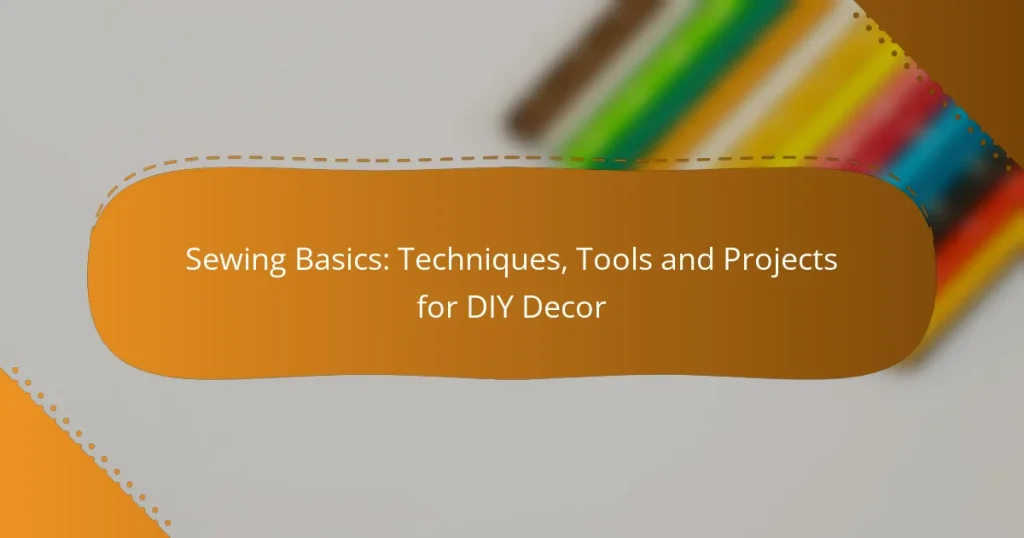Transforming your home with DIY decor techniques can be both rewarding and budget-friendly. From upcycling furniture to creating unique wall art, these methods not only enhance your living space but also promote sustainability. Explore creative ways to personalize your environment while making the most of what you already have.
Choosing Tools: Essential Equipment for DIY Home Decor Projects
Sewing Basics: Techniques, Tools and Projects for DIY Decor
DIY Home Decor Techniques: Stenciling, Decoupage and Painting
Power Tools: Safety, Usage and Maintenance for DIY Home Decor
Basic Woodworking: Techniques, Tools and Projects for DIY Decor
DIY Home Decor Skills: Essential Techniques, Tools and Tips
What are the best DIY home decor techniques?
The best DIY home decor techniques include upcycling furniture, creating wall art, using stencils for patterns, repurposing household items, and installing peel-and-stick wallpaper. These methods allow you to personalize your space while being cost-effective and environmentally friendly.
Upcycling furniture
Upcycling furniture involves transforming old or discarded pieces into something new and functional. This can be achieved through painting, reupholstering, or adding new hardware. For example, an old wooden chair can be sanded down and painted in a vibrant color to fit your decor style.
Consider the condition of the furniture before starting. If it’s structurally sound, it can be a great candidate for upcycling. Always use high-quality materials to ensure durability and a professional finish.
Creating wall art
Creating wall art is a straightforward way to add personality to your home. You can make pieces using canvas, wood, or even fabric. Simple techniques include painting abstract designs, framing fabric swatches, or creating a gallery wall with personal photos.
When designing wall art, think about the color scheme of your room. Choose colors that complement your existing decor to create a cohesive look. You can also use online tutorials for step-by-step guidance on various techniques.
Using stencils for patterns
Using stencils for patterns allows you to add intricate designs to walls, furniture, or textiles easily. Stencils can be purchased or made at home using cardstock or plastic sheets. They can be applied with paint or spray for a clean finish.
To achieve the best results, secure the stencil firmly to the surface to prevent paint bleed. Start with a light touch and build up color gradually. This technique is especially effective for creating borders or accent pieces in a room.
Repurposing household items
Repurposing household items involves finding new uses for things you already own, which can save money and reduce waste. For instance, glass jars can be turned into stylish storage containers, while old ladders can serve as unique bookshelves.
When considering repurposing, think creatively about the function of each item. Ensure that the new use is practical and fits well within your decor theme. This approach can add character and charm to your home.
Installing peel-and-stick wallpaper
Installing peel-and-stick wallpaper is a quick and easy way to refresh a room without the commitment of traditional wallpaper. This type of wallpaper adheres directly to the wall and can be removed easily, making it ideal for renters.
Before installation, ensure the wall surface is clean and smooth for the best adhesion. Measure your walls accurately and cut the wallpaper to size. Start from a corner and work your way across, smoothing out any bubbles as you go.
How can I upcycle furniture for home decor?
Upcycling furniture involves creatively repurposing old pieces to enhance your home decor while reducing waste. This process can include refinishing, painting, or adding new hardware to give furniture a fresh look and feel.
Refinishing wood surfaces
Refinishing wood surfaces can breathe new life into worn-out furniture. Start by sanding the surface to remove old finishes and imperfections, then apply a suitable wood stain or sealant to protect and enhance the natural grain.
Consider using eco-friendly stains and finishes to minimize harmful emissions. A good rule of thumb is to choose a product that meets local environmental standards, ensuring safety for indoor air quality.
Painting old furniture
Painting old furniture is an effective way to transform its appearance. Select a high-quality paint designed for furniture, which typically offers better adhesion and durability than standard wall paint.
Before painting, clean the surface thoroughly and apply a primer if necessary. For best results, use a brush or roller to achieve an even coat, and allow adequate drying time between layers. Popular colors include neutrals and pastels, which can complement various decor styles.
Adding new hardware
Adding new hardware, such as knobs and handles, can significantly update the look of your furniture. Choose styles that match your decor theme, whether modern, vintage, or rustic.
When replacing hardware, ensure that the new pieces fit the existing holes or be prepared to drill new ones. This simple change can enhance functionality and aesthetics, making your furniture feel brand new without extensive renovations.
What are effective ways to create wall art?
Effective ways to create wall art include using various materials and techniques that can transform your space. Popular methods involve framing fabric or wallpaper, utilizing canvas and paint, and designing a photo gallery.
Framing fabric or wallpaper
Framing fabric or wallpaper can add texture and color to your walls. Choose a fabric or wallpaper that complements your room’s color scheme, and use a simple frame to highlight it. This technique is particularly effective for creating a focal point in a room.
Consider using a large frame for a dramatic effect or a series of smaller frames for a more eclectic look. Ensure the fabric is taut and well-secured within the frame to maintain a polished appearance.
Using canvas and paint
Using canvas and paint allows for complete creative freedom in your wall art. You can create abstract designs, landscapes, or even personalized messages. Purchase blank canvases from local craft stores, which are available in various sizes to suit your space.
When painting, consider using acrylics for their quick-drying properties and vibrant colors. Experiment with different techniques, such as sponging or layering, to add depth to your artwork. Remember to protect your floors and furniture while you work.
Creating a photo gallery
Creating a photo gallery is an excellent way to showcase personal memories and add a personal touch to your decor. Select a theme for your gallery, such as family portraits, travel photos, or nature scenes, to create a cohesive look. Use frames of varying sizes and styles for an eclectic feel.
Arrange the photos on the floor before hanging them to find the best layout. Use a level to ensure that your frames are straight, and consider using adhesive strips for easy removal without damaging the walls. Regularly update your gallery with new photos to keep it fresh and engaging.
What tools do I need for DIY home decor?
To successfully tackle DIY home decor projects, you’ll need a combination of basic hand tools, power tools, and craft supplies. These tools will help you create, modify, and enhance your living spaces efficiently and effectively.
Basic hand tools
Basic hand tools are essential for any DIY home decor project. Common tools include a hammer, screwdrivers, pliers, a tape measure, and a utility knife. These tools allow you to perform tasks like hanging pictures, assembling furniture, and making precise measurements.
When selecting hand tools, consider investing in a quality set that includes a variety of sizes and types. This will save you time and frustration when tackling different projects. Always keep your tools organized and easily accessible to streamline your workflow.
Power tools
Power tools can significantly speed up your DIY home decor tasks and provide more precision. Essential power tools include a cordless drill, jigsaw, and circular saw. These tools are particularly useful for cutting materials, drilling holes, and assembling larger projects.
Before using power tools, familiarize yourself with their operation and safety features. Always wear appropriate safety gear, such as goggles and gloves, to protect yourself. Start with simpler projects to build your confidence and skill level before moving on to more complex tasks.
Craft supplies
Craft supplies are vital for adding personal touches to your home decor. Items such as paint, brushes, glue, fabric, and decorative elements can help you customize your projects. Consider your style and the overall theme of your space when selecting these materials.
When purchasing craft supplies, look for versatile options that can be used across multiple projects. For example, a good quality paint can be used for furniture, walls, and decorative items. Keep an organized inventory of your supplies to avoid unnecessary purchases and ensure you have what you need on hand.
How to choose the right colors for DIY projects?
Choosing the right colors for DIY projects involves understanding color harmony and the emotional impact of colors. Start by considering the purpose of the space and the mood you want to create, then select a color palette that aligns with those goals.
Using color theory
Color theory is a fundamental concept that helps you understand how colors interact and influence each other. It includes the color wheel, which categorizes colors into primary, secondary, and tertiary groups, and illustrates relationships such as complementary and analogous colors.
When selecting colors for your DIY projects, consider using complementary colors, which are opposite each other on the color wheel, to create contrast and vibrancy. For a more harmonious look, choose analogous colors, which are next to each other on the wheel, to create a soothing effect.
To apply color theory effectively, start with a dominant color for your main elements and then use one or two accent colors to enhance the overall design. A common approach is the 60-30-10 rule: 60% of the dominant color, 30% of a secondary color, and 10% of an accent color. This balance can help achieve a visually appealing result in your DIY projects.






